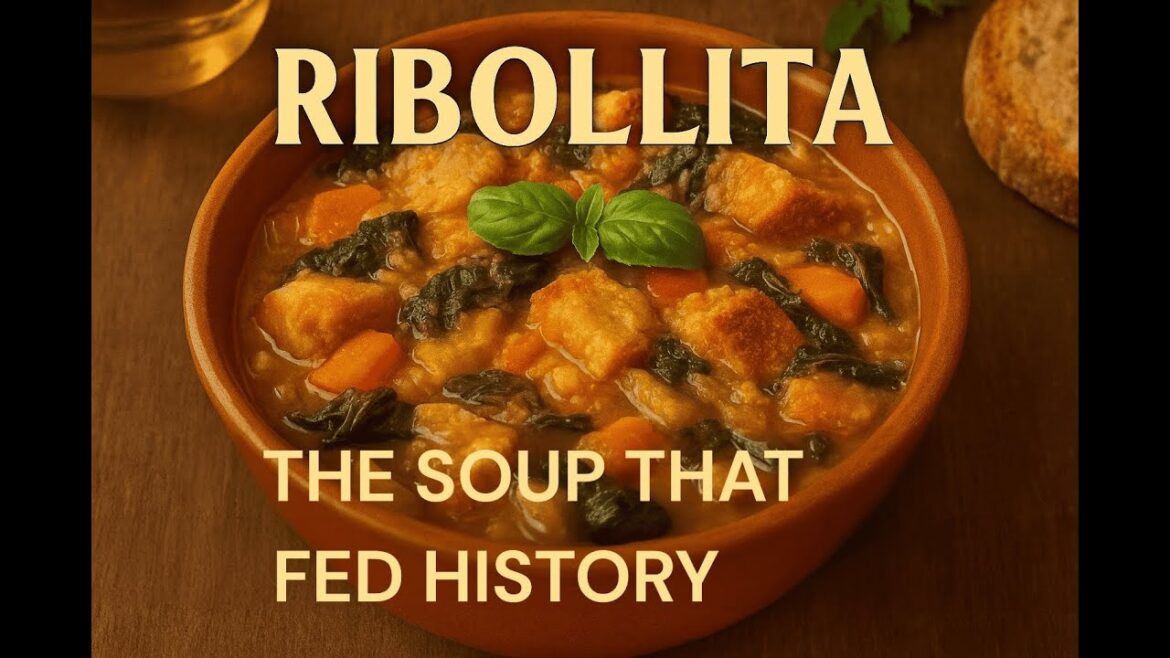Discover the legendary Tuscan Ribollita, the “reboiled” soup that turned humble leftovers into one of Italy’s most timeless dishes. Once a meal for peasants, now a masterpiece of flavor and history. In this video, Ivan from Padellando con Ivan brings you step by step through this rustic classic — from its ancient Roman roots to your modern table.
⸻
🥣 Ingredients (Serves 4–6)
• 250 g (9 oz) dried cannellini beans
• 300 g (10 oz) black kale (cavolo nero)
• 2 carrots
• 2 celery stalks
• 1 onion
• 2 ripe tomatoes (or 200 g canned)
• 4–5 slices stale Tuscan bread
• Extra virgin olive oil
• Salt & pepper to taste
⸻
🔪 Quick Steps
1. Cook the beans until tender, then set aside.
2. Sauté onion, carrot, and celery in olive oil.
3. Add kale, tomatoes, and beans, simmer for about 1 hour until thick.
4. Layer the soup with slices of stale bread in a pot.
5. Reheat (“reboil”) the next day for an authentic, deep flavor.
6. Serve with olive oil drizzle — simple, hearty, and historical.
⸻
📜 Fun Fact: Ancient Romans already made similar bean-and-vegetable soups. Centuries later, Tuscan peasants perfected it by reboiling leftovers — turning “poor” food into pure tradition.
👩🍳 Special Collaboration!
This video was created together with Selvaggia – salutebellezzaumore 💚
We’re joining forces to talk about cooking, health, wellness, and a touch of history — two channels, one shared passion for a healthy life!
🎥 Subscribe to the channel → [http://www.youtube.com/@UCP2SEwQ33DFSjOOm2TocPLg ]
🍝 Check out and subscribe to Selvaggia’s channel → [ @Selvaggia82 ]
📢 New videos every week:
Shorts: Wednesday and Saturday
Recipe: Tuesday and Friday
Sundays are for dessert — real recipes, real humor.
🧡 “I cook, I laugh, I survive.”
Because if something goes wrong… there’s always the pan!
#PadellandoConIvan #Ribollita #TuscanCuisine #ItalianFood #cookinghistory
[Chapter 1 – The Origins of Ribollita]
Today we’re making the Tuscan Ribollita, a dish not born in fancy restaurants, but in humble homes. This peasant soup carries a rich story that reaches back centuries, perhaps even to the times of ancient Rome.
Both the ancient Romans and Greeks were known for making hearty vegetable and bean stews, often cooked slowly over open fires. In the Middle Ages, Tuscan servants developed a resourceful practice. They would reuse leftover bread and vegetables, boiling them again the next day.
This ingenious method is precisely where the name ribollita originates, literally meaning “reboiled” in Italian. [Chapter 2 – The Ingredients]
The ingredients for ribollita are wonderfully simple, yet each plays an essential role in its authentic flavor.
We use black kale, creamy cannellini beans, fresh carrots, crisp celery, aromatic onions, rich extra virgin olive oil, and, of course, stale Tuscan bread.
Notice the absence of meat or butter. [Chapter 3 – The Cooking Process]
The true essence of this dish relies solely on patience and slow, gentle heat.
To begin, we’ll lightly sauté a finely diced onion, carrot, and celery in a generous amount of olive oil.
Once softened, we then incorporate the cannellini beans, the black kale, and the rest of our fresh vegetables. The real secret to ribollita lies in its slow simmer, allowing it to cook for at least an hour until it becomes wonderfully thick and fragrant.
Then comes the true magic: let it rest overnight and reheat it the next day.
That’s when ribollita truly transforms and becomes its most authentic self. Each time it’s reboiled, the flavors deepen and melt together even further, creating a more complex and satisfying taste.
It’s a dish that truly grows better with time, much like the timeless beauty and character of Tuscany itself.
And if you’re curious whether the ancient Romans would have approved, I’d confidently say yes. [Chapter 4 – The Final Touch]
They certainly had the concept of soup; they just didn’t have our beloved kale.
Once ready, serve your ribollita in a rustic bowl with a generous drizzle of the finest extra virgin olive oil and perhaps a fresh slice of bread.
Ribollita stands as a testament that humble cooking, when approached with heart and respect for ingredients, can become truly timeless. And if you happen to have any leftovers, please don’t throw them away.
Tomorrow it will be even better, richer, and more flavorful.
Thank you for joining me on this culinary journey.
See you in the next recipe, right here on Padellando with Ivan.


Dining and Cooking